|
|
|
mad monkey mother
Sunday, December 29 2019
location: room 19, Ghanerao Castle, Ghanerao, Rajasthan, India
There had been a loud Indian family in the room across the stairway that began banging around and talking loudly before 6:00am. They showed absolutely concern for other people who might be trying to sleep in the castle. And they went on being loud even after Gretchen got up and made a point of shutting the door either to their room or the hallway just outside it. A completely inconsiderate person is problem that's not easily fixed. Fortunately, they were gone a little after sunrise (7:30am).
[REDACTED]
After we got out of bed, Gretchen and I explored our building, venturing all the way to the roof. This building was separated by a courtard and an entryway from the building whose roof we'd explored yesterday, and we found it was structured a bit differently. Clearly these castles and palaces were designed to allow for frequent foot traffic (and relaxation) on their rooftops, which are made of concrete (as opposed to tar or other materials incompatible with foot traffic). On the roof yesterday, the edges had been bounded by low walls and occasional rails to keep people from stumbling off of them. These walls and rails are comically low, often knee-high or even lower, and this makes for a great unobstructed view. But in the part of the castle where our room was, the edges of the roof were surrounded by high (that is, eight-foot) walls made of perforated stone panels. These panels served as a loose screen, perhaps to permit people to look out from the roof and not be seen. Our guess was that, given the gendered modesty rules of India, our rooftop had been intended for women. Interesting, no two of the perforated stone panels were perforated with the same design. They're not the kind of thing one picks up in bulk from a Home Depot. There were many staircases, roofs, and rooms to explore, and many of these had fallen into neglect. They were full of things like pigeon droppings, wasp nests, and, in one case, a mammal turd so large that it had to either be from a monkey or a human.
After breakfast, our Indian guides held an "ask us anything" session in the dining room. I didn't have any good questions prepared. Perhaps I wanted to know how the pagan Mongols became Mughals and come to embrace Islam, but I could look that up in Wikipedia. Jokingly, I wondered if the extra hands and arms of a multi-armed god qualify as left or right hands in social protocol. Most of the good questions this morning concerned all the street animals. What role did they play? What kept them from starving. We'd noted a live-and-let-live attitude toward them that seemed noble in comparison to hierarchical western views of the natural world. But surely the cows needed to eat something more substantial than paper and plastic. And what about all the pigs. It turned out that there are rituals built into Hindu society to provide for some of street animals. For example, it's traditional to give the first roti (flat bread) of the day to a street cow and then give the last to a street dog. A roti isn't much for a cow, but it's a fair amount for a dog. And should the cow die from starvation or stomach problems resulting from eating plastic, the dogs will feast. As for the pigs, they apparently aren't raised for any sort of slaughter and are there to clean up the filthy biological refuse that no other creatures (not even dogs) will touch.
Later this morning our group went for a rambling walk all around Ghanerao, stopping to look at various things along the way, such as immaculate marble Jain temples and small step wells (none were deeper than about twenty feet). The latter had substantial accumulations of plastic debris and algæ floating on their surfaces. Some schoolgirls showed up and, in very rudimentary English, tried to get us to give them pens. But none of us had any. Knowing that pens are something Indian children are desperate to obtain made me feel better about our showy ritual of benefaction the other day in Roopangarh.
Along one street, we came upon a cow (followed by a dog) climbing the steps up into a house, where she was met by a woman with roti. It was good to understand what was going on.As had been the case everywhere else, the locals were super friendly. One group of boys even let us come into the dark, unlit room where they all lived. Using the flashlight on my phone, I saw that their place was very tidy and organized, and the main possessions were related to the cooking of food. One of the lads offered me water, which I politely declined.
We kept encountering puppies, some of which were sunning themselves right in the middle of the street. One such puppy didn't seem eager to get out of the way of a coming van, so I scootched him or her over with my foot, which made the puppy want to play. Gretchen, of course, kept kissing the puppies, which was probably why her father was charging well ahead of her in our group. To see that, he would've had to reprimand her, something he didn't want to do.
There has been coffee at breakfast here in Ghanerao Castle, but it's been strangely unsatisfying. It's a brown liquid that tastes like coffee, but it doesn't seem to do much to bring the day into focus, suggesting it doesn't have a whole lot of caffeine. That wouldn't be such a problem were it possible to make tea and coffee at other times of the day, but unfortunately our hot water options on this tour have been so bad that I'd briefly considerer perhaps making my own prison-style stinger. But when I went looking around in the dining hall looking to see what I might improvise, Zach (our American guide) popped up like he always does to ask if I needed something. This time I actually did, and he managed to scare up a thermos of hot water for me. This was how I managed to prepare a cup of hot kratom tea (I'd been getting by on its cold version, which is a miserable drink). Since yoga was happening in the afternoon today in the beautiful grassy courtyard, that was my main period of me-time today.
Late this afternoon we walked out past the pigs and puppies to the bus and took a short ride to the nearby Muchhala Mahavir Jain Temple. This was, we were told, a fairly small temple, and inside it definitely was. But there was a lot of outdoors to the temple, and the best thing about it was that it was home to a great many monkeys, in this case gray langurs, which have black faces and cream-colored hair. In the paking area out front, there were also dogs and cows, and even the monkeys with babies didn't seem the least bit concerned about the dogs. They evidently have some sort of understanding.
Interestingly, though the core of the temple is ancient, a large expansion in the form of post-and-lintel calles was underway. Modern concrete foundations had been poured and brand new marble columns, all of them intricately carved in the ancient manner, stood up upon them and then some of those had been covered with carved lintels. Since some of the standing columns had not yet been carved, it looked like the carving actually happened after the columns were installed. I wondered what would happen in the case of a stone carving error (the sort that can happen when chiseling into a natural material). We got a chance to go briefly into the interior of the temple itself, where it was very dark and we were forbidden from taking pictures. As we left the inner sanctum, we were told to walk backwards so as not to disrespect the idol.
In the interior grounds of the temple was a single puppy who was so adorable that the parents of "the family" in our entourage (Lee and his wife Alison and their two kids) relented and allowed the kids to touch. They'd been much better than Gretchen's father at preventing their children from any touching of the street dogs. In response, the little puppy became delightfully playful. I can't imagine a better place for a street puppy to find him or herself than the interior of a Jain temple.
After we exited the immediate temple grounds and were again in the parking lot, our local guide J brought out some biscuits to feed the monkeys, and they all came swinging out of the trees to partake in the bounty. J gave biscuits to various people in our entourage so they could individually hand them to monkeys, something Gretchen was very excited to do. Gretchen was delighted to find the monkeys actually touched her fingers as they took the biscuits, but when she lingered too long in the offering gesture after the biscuit had been taken (perhaps coupled with excessive eye contact) this apparently violated an unwritten rule regarding monkey-human transactions. Because when Gretchen did this, the mother monkey (with baby) on the receiving end of Gretchen's gift felt the need to assert boundaries. She slapped Gretchen on her right check, and this slap apparently included a little monkey fingernail because it left a
superficial scratch. This didn't bleed, but it slowly turned red and, over the course of the evening, became slightly puffy. She doesn't really mind receiving minor injuries from the wild animals she tries to love; she still wears a now-invisible penguin-inflicted scar on one of her hands like a badge.
Back at the castle, Gretchen's parents held a Hanukkah candle lighting at the "opium den" for any who wanted to attend. There were a surprising number of actual Jews in our group, but for the non-Jews (particularly our Indian guides, one of whom had said something decidedly antisemitic earlier in the tour), they gave the "for dummies" explanation.
Later, after dinner, Gretchen gave a reading of some of her poems for any who wanted to hear them, also at the opium den. It wasn't actually a reading, as Gretchen was able to recite them from memory, which made the presentation that much more powerful. One of Gretchen's goals for the reading of her animal-rights-related materials was to veganize the non-vegans in our group (of which there are a non-trivial number). Not everyone attended Gretchen's reading, but all the non-vegans happened to.
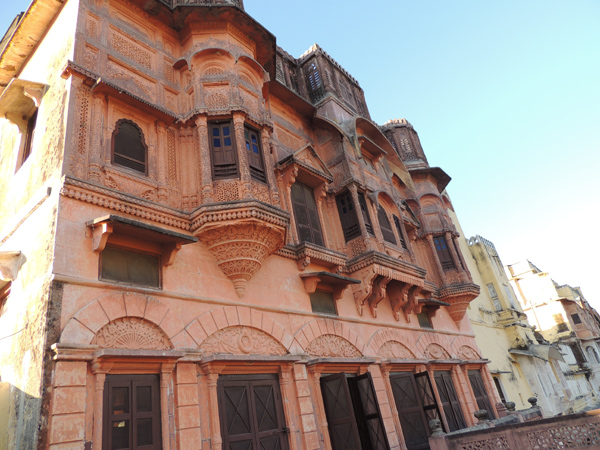
The façade of the part of Ghanerao Castle where our room was.
Click to enlarge.
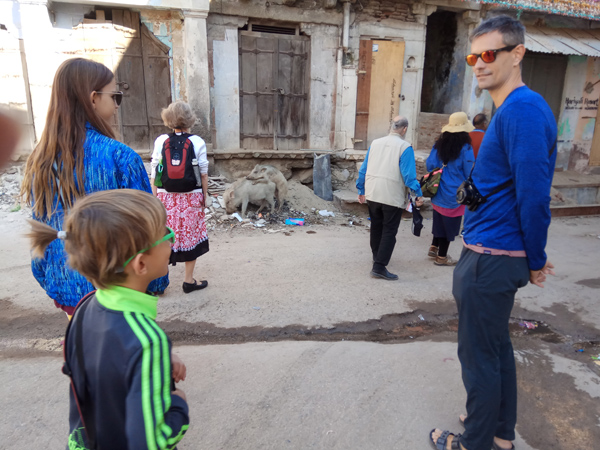
Most of "the family" of our group (that's the dad, Lee, on the right) as their kids come upon one pig mounting another today on our stroll through Ghanerao. Click to enlarge.
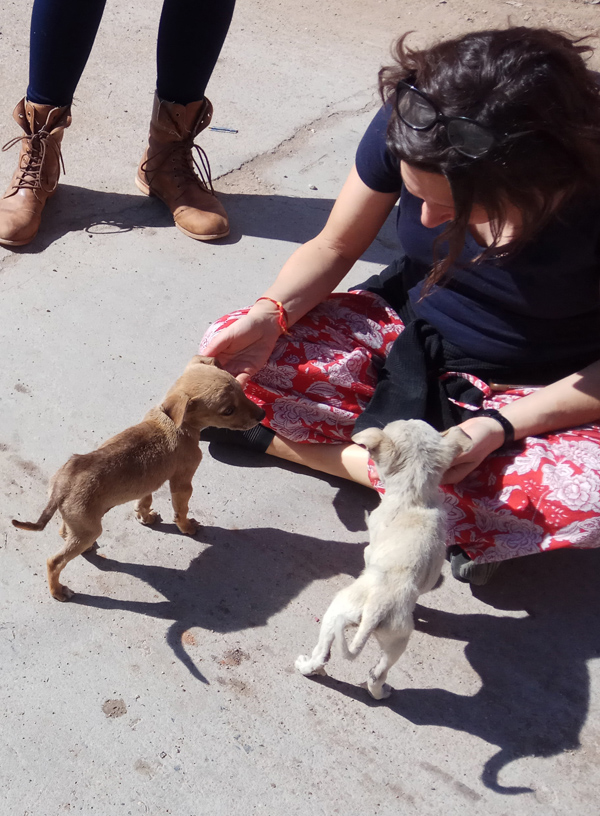
Gretchen loving on some street puppies.

Spotted pigs.

Dog with tongue.
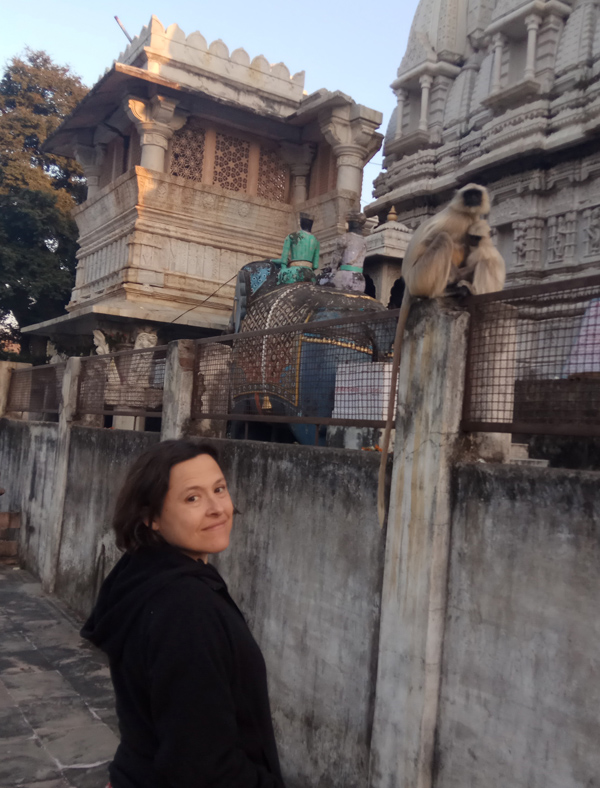
Gretchen admiring some temple monkeys.
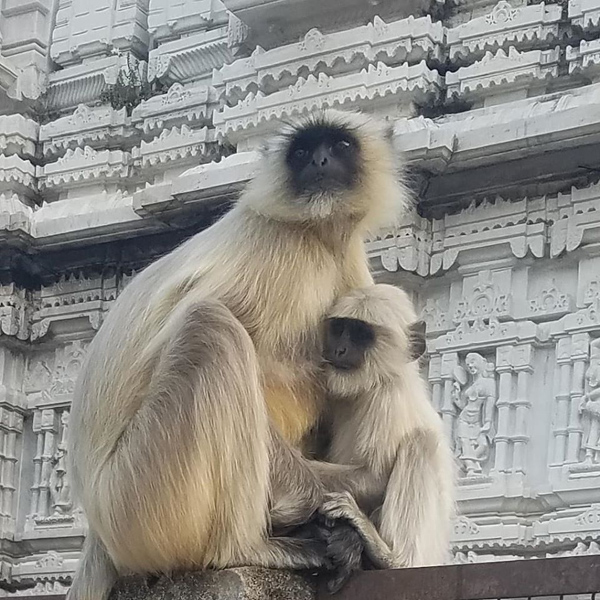
The picture Gretchen took of these monkeys with her phone. Click to enlarge.
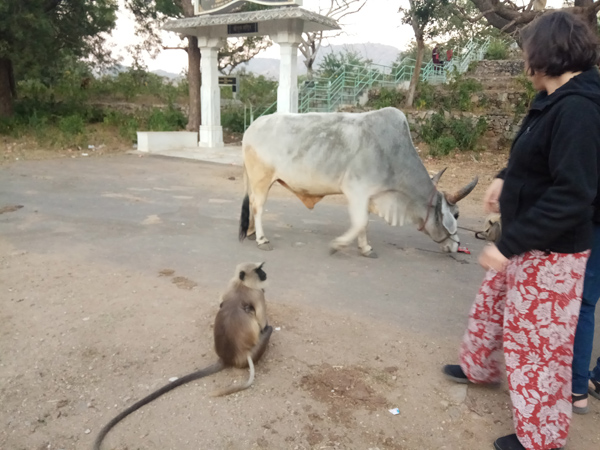
The mother monkey immediately after slapping Gretchen.
For linking purposes this article's URL is:
http://asecular.com/blog.php?191229 feedback
previous | next |







